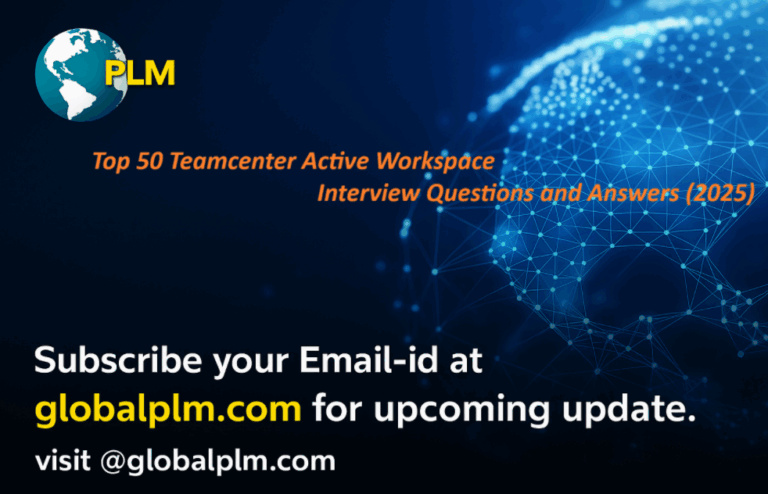Top 50 Teamcenter Active Workspace Interview Questions and Answers (2025)
- What is Teamcenter Active Workspace?
Answer: Teamcenter Active Workspace (AW) is a web-based, intuitive interface designed for PLM users to interact with Teamcenter from any device. It provides an easy-to-use search-driven interface for accessing product lifecycle data.
- How does Active Workspace differ from Teamcenter Rich Client?
Answer: Active Workspace is a lightweight, browser-based interface, whereas Teamcenter Rich Client is a full-featured, desktop application. AW provides faster and more intuitive access to PLM data with minimal installation requirements.
- What are the key features of Active Workspace?
Answer: Key features include:
- Web-based access
- Advanced search capabilities
- Visual navigation
- Workflow and task management
- BOM management
- What are the system requirements for Active Workspace?
Answer:
- Web browser support (Chrome, Edge, Firefox)
- Teamcenter server with Active Workspace components installed
- JavaScript and REST API support
- How do you configure Active Workspace in Teamcenter?
Answer: Configuration involves:
- Installing Active Workspace components on the Teamcenter server.
- Configuring the Active Workspace web application.
- Setting up authentication and security policies.
- How does Active Workspace use Teamcenter REST APIs?
Answer: AW interacts with Teamcenter using RESTful APIs, allowing seamless communication between web-based clients and the Teamcenter backend.
- What is the role of the FMS (File Management System) in Active Workspace?
Answer: FMS enables efficient file transfer and caching for managing CAD data and documents within Active Workspace.
- How does Active Workspace handle security and authentication?
Answer:
- Supports SSO (Single Sign-On) using SAML
- Uses LDAP for user authentication
- Implements role-based access control
- What is the difference between Active Workspace 4.x and 5.x?
Answer: Active Workspace 5.x introduces improved UI, better performance, enhanced search capabilities, and expanded cloud compatibility.
- How do you customize Active Workspace?
Answer: Customization can be done via:
- Custom stylesheets (CSS)
- Client-side extensions using JavaScript
- Server-side extensions with ITK and BMIDE
- What is a PLMXML file in Active Workspace?
Answer: A PLMXML file is an XML-based representation of PLM data used for data exchange between systems.
- What are Tiles in Active Workspace?
Answer: Tiles are the UI elements that provide quick access to different Teamcenter functionalities, such as Recent Files, My Tasks, or Saved Searches.
- How do you enable debugging in Active Workspace?
Answer: Debugging can be enabled using browser developer tools or by modifying the Active Workspace log settings.
- What are the common Active Workspace troubleshooting steps?
Answer:
- Verify browser compatibility.
- Check Teamcenter and AW server logs.
- Ensure REST API endpoints are accessible.
- How do you integrate Active Workspace with third-party applications?
Answer: Integration is achieved using Teamcenter SOA (Service-Oriented Architecture) and REST APIs.
- What is the role of the Active Workspace Client Framework?
Answer: It provides the foundational structure for the Active Workspace UI and handles interactions with Teamcenter services.
- How do you perform an advanced search in Active Workspace?
Answer: By using filters, wildcards, and metadata properties in the search bar.
- What is a Saved Query in Active Workspace?
Answer: A predefined search that users can execute repeatedly to retrieve specific data.
- What is the use of Active Workspace Change Management?
Answer: It helps manage engineering change requests, orders, and workflows efficiently.
- How does BOM management work in Active Workspace?
Answer: BOM management allows users to visualize, edit, and compare bill of materials data within Teamcenter.
Additional Questions
If anyone know the below answer of below question and please answer in comment section.
- What are the benefits of using Active Workspace over Teamcenter Thin Client?
- How does Active Workspace support cloud-based deployments?
- What is the role of Elasticsearch in Active Workspace?
- How do you configure language settings in Active Workspace?
- How do you perform object property editing in Active Workspace?
- What is the Active Workspace Data Model?
- How does Active Workspace handle notifications?
- What caching mechanism does Active Workspace use?
- How do you integrate CAD tools with Active Workspace?
- What role does Active Workspace play in digital twin solutions?
- How does Active Workspace handle version control?
- What security best practices should be followed in Active Workspace?
- How do you set up dashboards in Active Workspace?
- What is the difference between Active Workspace and Teamcenter Share?
- How do you deploy Active Workspace in a clustered environment?
- What is an Active Workspace Style Sheet?
- How do you implement Single Sign-On (SSO) in Active Workspace?
- How do you perform bulk data import/export in Active Workspace?
- How does Active Workspace handle 3D visualization?
- What is the role of Teamcenter Structure Manager in Active Workspace?
- How do you extend Active Workspace functionalities?
- How does Active Workspace support digital thread implementation?
- How do you configure the Active Workspace client cache settings?
- What troubleshooting steps should be taken when Active Workspace is slow?
- How do you configure Active Workspace licensing?
- What role does XML play in Active Workspace configurations?
- How do you enable dark mode in Active Workspace?
- How do you migrate from older Teamcenter versions to Active Workspace?
- How does Active Workspace interact with Teamcenter Visualization?
- What are the future trends in Active Workspace development?
========================================================================
Top most article of globalplm.
https://globalplm.com/teamcenter-project-synopsis/
Microsoft Visual Studio Project configuration for Teamcenter Unified ITK



